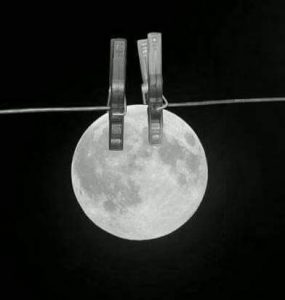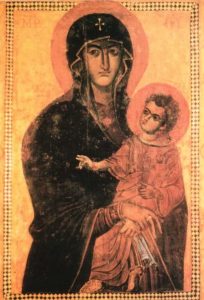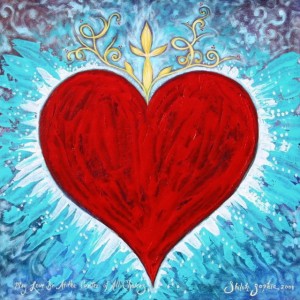 The blackberries are fermenting on the vine, fallen leaves blanket the picnic table, and the slice of sun on my clothesline arrives later each day. With the arrival of fall, the days of being able to hang my laundry outside are growing fewer. Lately I have been pondering my passion for this ritual of outdoor clothes drying. Is it only the sensual pleasure I crave, or something more?
The blackberries are fermenting on the vine, fallen leaves blanket the picnic table, and the slice of sun on my clothesline arrives later each day. With the arrival of fall, the days of being able to hang my laundry outside are growing fewer. Lately I have been pondering my passion for this ritual of outdoor clothes drying. Is it only the sensual pleasure I crave, or something more?
One of my early childhood memories is of being outside with my mother as she hung long rows of clothes with wooden clothespins. Sheets created a labyrinth of imagination. Half of the backyard in our Denver home at various times over the years was claimed by hanging laundry on those days. Numerous cloth diapers testified to the presence of a baby in the house. They hung beside the parochial school uniforms of my sisters and me, my father’s work clothes, my mother’s aprons, the envied “regular” clothes of my older sisters, my brothers’ play clothes, each item revealing something of our lives.
One year, for my birthday party, my mother organized a game in our backyard near the clothesline. The goal was to successfully drop clothespins into the small round opening of a glass milk bottle on the ground. One at a time each child knelt on a wooden chair, facing backward, their arm resting on the back of the chair. The person with the most clothespins in the bottle won. Now when my mother recalls this game she laughs with embarrassment of not having provided a more sophisticated activity. But we kids loved it. It stands out for me as a testament to my mother’s inventiveness of transforming everyday items into something special and marks with some nostalgia a certain time of growing up in the 1950s and 60s.
In Italy, rows of laundry hang publicly and “shamelessly” high above the streets of some cities and outside the windows of village homes. When I first visited my maternal grandmother’s village in 1980, some women still gathered at a public basin to wash their clothes. What stories were told as women did laundry together? My Italian cousin, Daria, deftly hung and strung laundry outside her centuries-old apartment window with a circulating line – reeling it in and out. It was the same line that her mother likely used to hang the laundry when she was alive and lived in that home. Cycles of time passed through the circulating line.
To honor my passion and pleasure of hanging laundry outside, I commissioned a local artist, Theresa Henson, to sculpt a pair of clothesline “poles,” each in the shape of the Goddess Tanit. I had first seen the symbol for this Goddess in Sicily in a mosaic of a Roman villa and, then again, a few years later on the island of Sardegna. Several women and I were on a study tour with Lucia Chiavola Birnbaum, a cultural historian and professor who informed us that Tanit’s veneration had arrived from North Africa, carried by the Phoenicians around the Mediterranean. Lucia’s research on primordial African migration routes opened my eyes to a much older lineage for sacred female imagery and for my European ancestry – that of a dark African mother.1
In Sardegna, Tanit’s presence in the lives of the ancients is evident in the form of a 3000 year-old “holy well,” a remarkable structure of basalt blocks expertly crafted and fitted together to create the triangular shape of her body. Twenty-five smooth stone stairs descend into subterranean space to reach the spring water held below. Twice a year, at the end of the winter and at the beginning of autumn, the sun’s beams align with the angle of the steps to penetrate the waters of the well. Precious bronze ex-voto, gifts of gratitude and devotion, have been found at the well, now known as the well of Santa Cristina, further marking it as an ancient sacred site. Descending the steps like so many pilgrims before me, “entering Tanit’s body,” and blessing myself with the holy water marked a meaningful event in my life. Now, as then, water heals, sanctifies, and washes away.
The bearers of my backyard clothesline, carved of reclaimed Redwood, are no less remarkable or substantial. Their color evokes the red ochre of the oldest sacred artistic pigment, as well as the life-giving blood of the mother. Enduring geometrical forms define their shapes: a downward-opening triangle for the body and a round circle for the head, which together mark the distinctive symbol for Tanit. Their features were selected from twenty reproductions of Tanit illustrated by Italian architect Franco Laner, who refers to the well of Santa Cristina as a temple.2 One of the clothesline Tanits has her “arms” raised in an orans, or praying pose, an ancient sign in sacred iconography for worship or epiphany. The other Tanit has a simple horizontal bar for arms and a crescent moon for her headdress. The lunar adornment links her with menstruation, since the length of both the moon’s cycle and the menstrual cycle is 29 ½ days. A further lunar connection has been made by archeo-astronomists in Sardegna, who, after studying the sacred well of Santa Cristina, have discovered that the circular stone opening above Tanit’s body aligns with the full moon. Every 18 ½ years, in the middle of the night at the darkest time of the year, the milky moonlight enters the round hole at the surface and shines directly down the bottle-shaped stone column into the water. This holy well is an exquisite vessel of cosmic and Earthly communion, as moon and sun come together in the waters held within the earth and stone, all sanctified inside the female body of the Goddess.
In sharing news and photos of my clothesline, I heard from friends across the country with their own fond memories of outdoor laundry, often beginning with “I remember when. . .” Sicilian American poet Maria Fama sent me her tribute to laundry in a poem, “In Love with the Laundry.” I learned of Roberta Cantow’s documentary film “Clotheslines” in which she pays homage to women, their work, and their stories.3 I discovered Holly Smith Pedlosky’s photographs of a Venetian mural in Giudecca of Our Lady of the Biancheria, 4 who blesses the laundry below and affirms her presence in everyday spirituality. Spinning fibers and weaving them into cloth falls under divine female protection. Women have sat together spinning and weaving for millennia, according to Elizabeth Wayland Barber who has researched the making of cloth and clothing over the last 20,000 years.5 In the village tradition of the Italian Alps, peasant families gathered together in the stables during the evenings of the winter months for the filò, a dialect word from the verb filare, meaning to spin. 6 Women spun wool, flax, or hemp and men worked on their tools while the storytellers spun tales in a communal setting, a practice still in existence in the 20th century.
The two Tanits, with silvery clothesline strung between them, stand outside my office window like guardian oracles of ancestral winds. Inside, at my computer, I am working to retrieve my ancestral heritage as part of my dissertation research. Over the months, I have been interviewing my elder female relatives in Colorado and in Italy asking about their lives. From them, I am learning about the life of my maternal grandmother, Edvige Albasini, who died three years before I was born. A century ago, she and my other grandparents emigrated from alpine villages in Trentino, the mountainous region of the Dolomites in what is now northern Italy. Edvige’s destination was Russell Gulch, Colorado, a rustic gold-mining town. Like many wives of miners, she was soon widowed, in her case at a young age with a family of three small children. “Taking in laundry” of wealthy people enabled Edvige to manage.
After Edvige remarried and the expanding family moved to Denver, doing the family laundry by hand was a sizable task, which, as daughters, my mother and her sisters were assigned to do. Clothes were placed in a boiler by my grandmother and then carried to a tub where the girls wrung them out and then hung them outside on lines – all of this before going to school. If wintry weather arrived during the day, frozen clothes were relocated inside on long lines strung across the dining room. At age 94, my mother’s oldest sister, Aunt Annie, relayed the details of this chore without a trace of fondness. She noted as a memorable event the time when a neighbor gave my grandmother a wringer washer, an upgrade from her washer board. After decades of line-drying the laundry, both Mother and Aunt Louise remembered clearly when they each finally were able to purchase an electric clothes dryer for their growing families.8
My mother, Lena, does the wash on Monday, as her mother did, and as they did growing up. In Italian, the word for Monday is lunedi, after luna, the moon. Lunar cycles permeate my peasant heritage. The phase of the moon governs plant growth, whether fermentation and distillation will be successful, and how quickly hair and nails grow. The luna crescente, the waxing moon, invigorates; the luna calante, the waning moon, mediates.9 Lunar rays of the full moon could impregnate, according to the lore of one village in the old country, perhaps recognizing the entrainment of women’s menstrual cycle with that of the moon. Menstrual practices, along with lunar practices, survived into the last century in Trentino – including rules about not touching living flowers or metal, and not washing one’s hair during the menstrual period. Honoring times of menstruation (or “le regole,” as it was once called, which translates as “the rules”), links these women to a long line of female ancestors who respected the awesome power of women’s life-giving blood.10 Our oldest foremothers practiced menstrual seclusion rites and maintained strict taboos that kept the blood sacred or separate, according to the cross-cultural research of Judy Grahn, who theorizes that these primordial rites are the origins of all ritual, which allowed the formation of culture.11
In my childhood dream, I am standing alone at night in the backyard between the clothesline and the apple tree. The white beam of the full moon shines from high above and bathes over me. Slowly it begins to lift me up off the ground back to its source. My heart is racing.
Was I remembering my lunar lineage? Were my female ancestors beckoning for me to someday remember their traditions?
Hanging clothes outside for me, in the 21st century, enfolds simple pleasures and deeply held values: the smell of clothes that have been dried by the wind and sun, spending time outside, conserving electric energy, and doing one small thing to reduce my legacy of consumption. In my visits to the folk museums of Trentino, I have witnessed all the stuff of everyday life made by hand. It is impressive – and humbling – to realize that these people of the mountains knew how to make everything: a variety of containers, every type of clothing, all food and drink, utensils, tools, and shelter. Older women were valued for their extensive knowledge of childbirth and healing remedies learned from a lifetime of careful observation and care-giving. The elders knew (and some still know) where the likely places for wild brise mushrooms are, which herbs to use for medicine, and the specific healing properties of the various mineral springs.
From my vantage point of mid-life, the laundry line feels like a connection to my female lineage, my motherline.12 Not in drudgery, although this task of keeping clothes washed and dried has been formidable over the ages; but in the ritual act itself of hanging clothes, and in the stories that settle around women’s lives in the creation and care of clothes. As we retrieve our mother’s stories and those of other female relatives we reclaim the value of women’s lives in history and restore our inner connection with the timelessness of the cycle of life.
(This article is an excerpt from from She Is Everywhere! Volume 3, (2012) co-edited by Mary Saracino and Mary Beth Moser.)
PHOTO CREDIT: Mauro de Angelis
Notes
1 Lucia Chiavola Birnbaum, dark mother: African origins and godmothers, (Lincoln: Authors Choice Press, 2001).
2 Franco Laner, Il Tempio a Pozzo di Santa Cristina: Storia, Technologia, Architettura e Astronomia, (Mestre, Sardinia: Guida 2 Edizioni Adrastea, 2004), 36.
3 See more on the film Clotheslines in Filmakers Library, http://www.filmakers.com/index.php?a=filmDetail&filmID=173
4 Photo of La Madonna Della Biancheria by Holly Smith Pedlosky: http://www.pedlosky.org/artlinks.html
5 Elizabeth Wayland Berber, Women’s Work: The First 20,000 Years, (New York: W.W. Norton & Company, 1994), 29.
6 Elizabeth Mathias and Richard Raspa in Italian Folktales in America: The Verbal Art of an Immigrant Woman, (Detroit: Wayne State University Press, 1985), 3.
7 The filò is portrayed visually in the film L’Albero degli Zoccoli, The Tree of Wooden Clogs (1978), directed by Ermanno Olmi.
8 From interviews with Ann Ress, Louise Kulp, Emma Fortarel, and Lena Moser conducted in May, 2009.
9 Doing laundry during the waning cycle of the moon, with its dissolving energy, helps make biancherie – linens and cottons – whiter, according to Johanna Paungger, who documents numerous lunar-related traditions of her Tyrolean childhood which she still practices. Johanna Paungger and Thomas Poppe, Servirsi della Luna: il suo influsso positivo su natura, salute,e vita quotidiana, (Milano: TEA, 2004), 152.
10 Details regarding recent menstrual practices were kindly provided to me by Giuseppina Trentini of Rovereto in Trentino, Italy via personal correspondence in November, 2010.
11 Judy Grahn, Blood Bread and Roses: How Menstruation Created the World, (Boston: Beacon Press, 1993).
12 See Naomi Ruth Lowinsky, The Motherline: Every Woman’s Journey to Find Her Female Roots, (New York: Jeremy P. Tarcher/Perigee Books, 1992), for more information on the concept of the motherline and on the importance of researching the stories of female family members.
Bibliography
Berber, Elizabeth Wayland. Women’s Work: The First 20,000 Years. New York: W.W. Norton & Company, 1994.
Birnbaum, Lucia Chiavola. dark mother: African origins and godmothers. Lincoln: Authors Choice Press, 2001.
Grahn, Judith Rae. Blood Bread and Roses: How Menstruation Created the World. Boston: Beacon Press, 1993.
Laner, Franco. Il Tempio a Pozzo di Santa Cristina: Storia, Technologia, Architettura e Astronomia. Mestre, Sardinia: Guida 2 Edizioni Adrastea, 2004.
Lowinsky, Naomi Ruth. The Motherline: Every Woman’s Journey to Find Her Female Roots. New York: Jeremy P. Tarcher/Perigee Books, 1992.
Mathias, Elizabeth and Richard Raspa. Italian Folktales in America: The Verbal Art of an Immigrant Woman. Detroit: Wayne State University Press, 1985.
Paungger, Johanna and Thomas Poppe, Servirsi della Luna: il suo influsso positivo su natura, salute,e vita quotidiana. Milano: TEA, 2004.

 This summer I received a postcard from a friend in Italy portraying the Madonna in the Basilica of Santa Maria Maggiore, the major church in Rome dedicated to the Virgin Mary. Far more than a just a beautiful image, this Black Madonna has been attributed with miraculous and awesome power. Her titles “Our Lady of the Snows” and “Salvation of the Roman People” offer clues of her power over the weather and her ability to protect a whole community.
This summer I received a postcard from a friend in Italy portraying the Madonna in the Basilica of Santa Maria Maggiore, the major church in Rome dedicated to the Virgin Mary. Far more than a just a beautiful image, this Black Madonna has been attributed with miraculous and awesome power. Her titles “Our Lady of the Snows” and “Salvation of the Roman People” offer clues of her power over the weather and her ability to protect a whole community.
 I am standing under the light of the full moon near the apple tree in the backyard of my home. Suddenly the light of the moonbeam begins to lift me up, off the ground, towards the moon. I awake, frightened, my heart beating fast.
I am standing under the light of the full moon near the apple tree in the backyard of my home. Suddenly the light of the moonbeam begins to lift me up, off the ground, towards the moon. I awake, frightened, my heart beating fast.